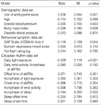1. Borbély AA. A two process model of sleep regulation. Hum Neurobiol. 1982. 1:195–204.
2. Regestein QR, Friebely J, Shifren JL, Scharf MB, Wiita B, Carver J, Schiff I. Self-reported sleep in postmenopausal women. Menopause. 2004. 11:198–207.

3. Cirignotta F, Mondini S, Zucconi M, Lenzi PL, Lugaresi E. Insomnia: an epidemiological survey. Clin Neuropharmacol. 1985. 8:Suppl 1. S49–S54.

4. Kessler RC, McGonagle KA, Swartz M, Blazer DG, Nelson CB. Sex and depression in the National Comorbidity Survey. I: Lifetime prevalence, chronicity and recurrence. J Affect Disord. 1993. 29:85–96.

5. Young T, Finn L, Austin D, Peterson A. Menopausal status and sleep-disorder breathing in the Wisconsin Sleep Cohort study. Am J Respir Crit Care Med. 2003. 167:1181–1185.
6. Kripke DF, Brunner R, Freeman R, Hendrix S, Jackson RD, Masaki K, Carter RA. Sleep complaints of postmenopausal women. Clinical Journal of Women's Health. 2001. 1:244–252.

7. The Women's Health Initiative Study Group. Design of the Women's Health Initiative clinical trial and observational study. Control Clin Trials. 1998. 19:61–109.
8. Tuunainen A, Kripke DF, Elliott JA, Assmus JD, Rex KM, Klauber MR, Langer RD. Depression and endogenous melatonin in postmenopausal women. J Affect Disord. 2002. 69:149–158.

9. Wallace-Guy GM, Kripke DF, Jean-Louis G, Langer RD, Elliott JA, Tuunainen A. Evening light exposure: implications for sleep and depression. J Am Geriatr Soc. 2002. 50:738–739.

10. Kripke DF, Jean-Louis G, Elliott JA, Klauber MR, Rex KM, Tuunainen A, Langer RD. Ethnicity, sleep, mood, and illumination in postmenopausal women. BMC Psychiatry. 2004. 4:8.

11. Yoon IY, Kripke DF, Elliott JA, Langer RD. Naps and circadian rhythms in postmenopausal women. J Gerontol A Biol Sci Med Sci. 2004. 59:844–848.

12. Matthews KA, Shumaker SA, Bowen DJ, Langer RD, Hunt JR, Kaplan RM, Klesges RC, Ritenbaugh C. Women's health initiative. Why now? What is it? What's new? Am Psychol. 1997. 52:101–116.

13. Levine DW, Kaplan RM, Kripke DF, Bowen DJ, Naughton MJ, Shumaker SA. Factor structure and measurement invariance of the Women's Health Initiative Insomnia Rating Scale. Psychol Assess. 2003. 15:123–136.

14. Burnam MA, Wells KB, Leake B, Landsverk J. Development of a brief screening instrument for detecting depressive disorders. Med Care. 1988. 26:775–789.

15. Tuunainen A, Langer RD, Klauber MR, Kripke DF. Short version of the CES-D (Burnam screen) for depression in reference to the structured psychiatric interview. Psychiatry Res. 2001. 103:261–270.

16. First MB, Spitzer RL, Gibbon M, Williams JBW. Structured Clinical Interview for DSM-IV Axis I Disorders-non-patient Edition (SCIDI/NP, Version 2.0). 1996. New York: New York State Psychiatric Institute.
17. Jean-Louis G, Kripke DF, Cole RJ, Assmus JD, Langer RD. Sleep detection with an accelerometer actigraph: comparisons with polysomnography. Physiol Behav. 2001. 72:21–28.

18. Webster JB, Kripke DF, Messin S, Mullaney DJ, Wyborney G. An activity-based sleep monitor system for ambulatory use. Sleep. 1982. 5:389–399.

19. Aldhous ME, Arendt J. Radioimmunoassay for 6-sulphatoxymelatonin in urine using an iodinated tracer. Ann Clin Biochem. 1988. 25:298–303.

20. Carskadon MA, Dement WC, Mitler MM, Guilleminault C, Zarcone VP, Spiegel R. Self-reports versus sleep laboratory findings in 122 drug-free subjects with complaints of chronic insomnia. Am J Psychiatry. 1976. 133:1382–1388.
21. Tang NK, Harvey AG. Effects of cognitive arousal and physiological arousal on sleep perception. Sleep. 2004. 27:69–78.

22. Katz DA, McHorney CA. Clinical correlates of insomnia in patients with chronic illness. Arch Intern Med. 1998. 158:1099–1107.

23. Buysse DJ, Reynolds CF 3rd, Hauri PJ, Roth T, Stepanski EJ, Thorpy MJ, Bixler EO, Kales A, Manfredi RL, Vgontzas AN, Stapf DM, Houck PR, Kupfer DJ. Diagnostic concordance for DSM-IV sleep disorders: a report from the APA/NIMH DSM-IV field trial. Am J Psychiatry. 1994. 151:1351–1360.
24. Bachmann GA. Vasomotor flushes in menopausal women. Am J Obstet Gynecol. 1999. 180(3 Pt 2):S312–S316.

25. Urponen H, Vuori I, Hasan J, Partinen M. Self-evaluations of factors promoting and disturbing sleep: an epidemiological survey in Finland. Soc Sci Med. 1988. 26:443–450.

26. Montgomery P, Dennis J. Physical exercise for sleep problems in adults aged 60+. Cochrane Database Syst Rev. 2002. CD003404.

27. Youngstedt SD, Perlis ML, O'Brien PM, Palmer CR, Smith MT, Orff HJ, Kripke DF. No association of sleep with total daily physical activity in normal sleepers. Physiol Behav. 2003. 78:395–401.

28. Scherrer JF, Xian H, Bucholz KK, Eisen SA, Lyons MJ, Goldberg J, Tsuang M, True WR. A twin study of depression symptoms, hypertension, and heart disease in middle-aged men. Psychosom Med. 2003. 65:548–557.

29. Aoki H, Yamada N, Ozeki Y, Yamane H, Kato N. Minimum light intensity required to suppress nocturnal melatonin concentration in human saliva. Neurosci Lett. 1998. 252:91–94.

30. Youngstedt SD, Kripke DF, Elliott JA. Melatonin excretion is not related to sleep in the elderly. J Pineal Res. 1998. 24:142–145.









 PDF
PDF ePub
ePub Citation
Citation Print
Print




 XML Download
XML Download